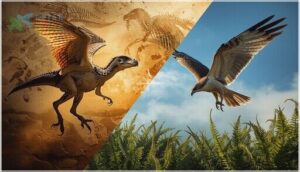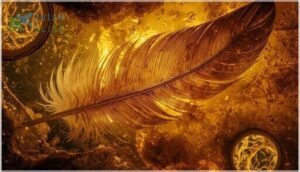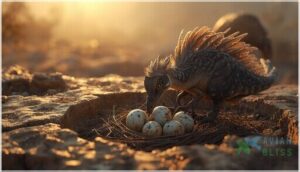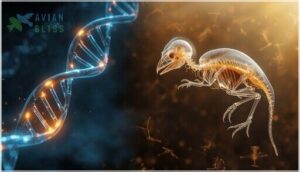This site is supported by our readers. We may earn a commission, at no cost to you, if you purchase through links.

When you watch a robin tug a worm from your lawn or a hawk circle overhead, you’re witnessing something extraordinary—living dinosaurs in action. This isn’t poetic license or loose metaphor. Birds are dinosaurs, as much as a poodle is a dog or a tiger is a cat.
Over 99% of paleontologists accept this classification, backed by fossil evidence spanning 150 million years, genetic markers in modern bird DNA, and anatomical features that haven’t changed since the Mesozoic. The evidence doesn’t suggest a connection—it proves direct lineage.
Understanding why scientists reclassified your backyard sparrows as theropod dinosaurs requires looking at bones, feathers, and evolutionary history in ways that transform how you see every bird you encounter.
Table Of Contents
- Key Takeaways
- Are Birds Actually Dinosaurs?
- Shared Features Between Birds and Dinosaurs
- The Evolutionary Link: From Theropods to Birds
- Fossil Evidence Supporting The Bird-Dinosaur Connection
- Genetic and Developmental Evidence
- How Birds Survived The Mass Extinction
- Implications for Modern Birds and Conservation
- Frequently Asked Questions (FAQs)
- Is a dinosaur a mammal or a bird?
- Is there a bird similar to Dinosaur and how?
- Did dinosaurs behave like birds?
- Are birds dinosaurs yes or no?
- Which bird is closest to dinosaurs?
- When did birds get classified as dinosaurs?
- Are birds the only dinosaurs left?
- Is a bird a dinosaur?
- Why don’t we call birds dinosaurs?
- How did dinosaur eggs differ from modern bird eggs?
- Conclusion
Key Takeaways
- Birds aren’t just descended from dinosaurs—they’re living theropod dinosaurs themselves, with over 99% of paleontologists confirming this classification through fossil records, genetic markers, and anatomical evidence spanning 150 million years.
- The evolutionary link runs through shared features like hollow bones, wishbones, three-toed limbs, feathers (which originally evolved for insulation, not flight), and identical nesting behaviors preserved in fossils dating back 70 million years.
- Key transitional fossils like Archaeopteryx and Microraptor capture evolution mid-stride, showing asymmetrical flight feathers alongside dinosaur teeth and four-winged anatomy that bridges the gap between ground-dwelling predators and modern flyers.
- Birds survived the asteroid impact that killed other dinosaurs 66 million years ago because their small size, feathered insulation, flight ability, and generalist diets gave them the adaptability to exploit new ecological niches during catastrophic environmental collapse.
Are Birds Actually Dinosaurs?
When you look at a sparrow hopping across your driveway, you’re watching a living dinosaur—not a distant relative, but the real thing. The scientific community doesn’t debate this anymore.
When you watch a sparrow hop across your driveway, you’re watching a living dinosaur—not a distant relative, but the real thing
What we’re exploring now is how birds fit into the dinosaur family tree, what makes them unique among their dinosaurian cousins, and why the evidence for this connection is so overwhelming.
Scientific Consensus on Bird-Dinosaur Relationship
The scientific consensus on birds is settled: they are dinosaurs. Over 99% of paleontologists agree based on fossil record analysis and phylogenetic research showing birds as living theropods. Paleontological debates still exist, but they’re about evolutionary details—not whether the dinosaurian traits and evolutionary link between birds and dinosaurs exist.
Consider what this means:
- Avian evolution rewrites extinction: Dinosaurs never truly vanished—they fly overhead daily
- Every sparrow carries T. rex DNA: The connection isn’t symbolic; it’s literal family history
- You’re watching dinosaur evolution unfold: Bird behavior reflects millions of years of adaptation
The study of bone canaliculi structure provides strong evidence for the dinosaur-bird connection.
Birds Within The Dinosaur Family Tree
Birds don’t just resemble dinosaurs—they occupy a specific branch of the dinosaur family tree. Phylogenetic analysis places them squarely within Theropoda, the group of bipedal carnivores. Your backyard robin shares dinosaur ancestry with dromaeosaurs and troodontids, those “raptors” that roamed millions of years ago.
Avian origins trace back through this theropod group, where feathered dinosaurs gradually acquired flight-capable traits. Avian evolution and diversity stem directly from these theropod connections—living proof that dinosaur evolution never stopped.
The study of bird genomics provides further insight into the complex relationships between birds and their dinosaur ancestors.
Defining Features of Avian Dinosaurs
What sets avian dinosaurs apart? You’ll find skeletal adaptations like hollow bones and a fused wishbone—features critical to flight mechanics. Feather evolution marks another turning point, with Archaeopteryx showcasing asymmetrical flight feathers. Theropod group members developed keeled sternums anchoring powerful flight muscles.
Beak development replaced teeth in later lineages, while feathered dinosaurs displayed avian intelligence through nesting behaviors. These birdlike dinosaurs illustrate avian evolution and diversity rooted in dinosaur ancestry.
Shared Features Between Birds and Dinosaurs
When you place a modern chicken skeleton next to a Velociraptor, the similarities are hard to ignore. Birds didn’t just evolve from dinosaurs—they carry forward a suite of physical traits that link them directly to their theropod ancestors.
Let’s look at the key features that birds and dinosaurs share, from their bones to their behavior.
Skeletal and Anatomical Similarities
When you look at a chicken’s skeleton next to a Velociraptor’s, the similarities jump out. Both share hollow bones that reduce weight, a wishbone for muscle attachment, and those distinctive three-toed limbs.
Skeletal pneumaticity—air pockets within bones—appears in modern birds and their theropod ancestors alike.
Even skull evolution shows birds retaining cranial features with remarkably less variation than their non-avian dinosaur relatives.
Feathers and Their Functions
Feathers started as insulation, not flight gear. Fossil evidence of feathers shows down-like protofeathers helped dinosaurs retain body heat—cutting heat loss by up to 90%. As feather evolution continued, these structures branched into multiple roles:
- Flight mechanics emerged with flexible, pennaceous flight feathers around 160 million years ago
- Display feathers with vibrant pigmentation enabled social signaling and mate selection
- Camouflage strategies like countershading concealed at least 40% of feathered dinosaurs from predators
- Feather insulation reduced body heat loss by 5- to 10-fold in prehistoric species
Egg-laying and Nesting Behaviors
Fossilized nests reveal that reproductive strategies haven’t changed much since the age of dinosaurs. You’ll find colonial breeding sites where titanosaurs nested together—over 250 nests clustered in just 2.5 km². Site fidelity, the repeated use of the same nesting grounds, appears in both early Jurassic Massospondylus and various Late Cretaceous dinosaurs, showing that birds inherited their nesting behavior from avian dinosaurs.
| Dinosaur Group | Nest Architecture | Egg Incubation Strategy | Brooding Behavior | Colonial Breeding |
|---|---|---|---|---|
| Theropods | Open-cup, partial burial | Active brooding, body heat | Yes (Oviraptorosauridae, Troodontidae) | Limited evidence |
| Sauropods | Sandy in-filled holes | Solar/geothermal heat | No direct care | Yes (high density) |
| Hadrosaurs | Organic mound nests | Microbial decomposition heat | Minimal to none | Some evidence |
| Early Birds | Covered nests, diverse | Active incubation | Yes (like modern birds) | Variable |
| Modern Birds | Open-cup, covered, platform | Active body heat transfer | Yes (widespread) | Common in many species |
Nest construction varied dramatically. Theropods like Troodon formosus arranged 10–20 eggs in open nests, while sauropods buried up to 100 eggs in shallow pits. This egg arrangement optimized heat transfer—critical for successful hatching. Brooding behavior, where adults positioned themselves over nests, dates back at least 70 million years in maniraptoran theropods.
The fossil evidence shows two main nest types: organic-rich mounds that generated heat through decomposition, and sandy holes that relied on environmental warmth. These reproductive strategies mirror what you see in modern birds today, from megapodes that build compost heaps to penguins that huddle over eggs in freezing conditions.
Respiratory and Metabolic Traits
Birds didn’t just inherit hollow bones from theropod dinosaurs—they got something far more extraordinary. The respiratory systems linking avian theropods to modern birds reveal dinosaur traits in birds that powered their evolutionary biology success:
- Unidirectional airflow through rigid lungs extracts 40% more oxygen than mammalian systems
- Air sac systems create continuous gas exchange during both inhalation and exhalation
- Metabolic rates run 3-11 times higher than similarly sized reptiles
- Respiratory efficiency enabled survival when atmospheric oxygen dropped to just 11%
This avian lung function represents evolutionary continuity spanning 150 million years.
The Evolutionary Link: From Theropods to Birds
The path from ancient theropods to modern birds isn’t a mystery anymore—it’s written in stone, feather impressions, and the bones of creatures that walked the line between dinosaur and bird. You’ll see this transformation play out through specific ancestors, striking fossils that caught evolution mid-stride, and a timeline that spans millions of years.
Let’s trace this evolutionary journey from the ground up.
Theropod Dinosaurs as Bird Ancestors
You’ve probably walked past a modern-day theropod this morning—pigeons are direct descendants of these bipedal predators. Cladistic analyses consistently place birds within Maniraptora, a specialized branch of coelurosaurian theropods that evolved during the Mesozoic.
Theropod evolution gave birds their hollow bones, three-toed limbs, and those distinctive claws you see gripping branches today. The fossil records show this isn’t speculation—it’s an unbroken anatomical lineage spanning 150 million years.
Key Transitional Fossils (e.g., Archaeopteryx, Microraptor)
Think of transitional fossils as evolutionary snapshots—Archaeopteryx gives you the clearest picture. All eleven specimens from 150 million years ago show asymmetrical flight feathers alongside dinosaur teeth and bony tails.
Microraptor adds another layer with its four-winged anatomy from 120 million years ago, bridging the dinosaur-bird shift. These feathered dinosaurs aren’t missing links—they’re documented proof of bird origins.
Timeline of Bird Evolution
Understanding the evolutionary path from dinosaurs to modern birds requires looking back about 150 million years. The fossil record reveals three critical phases:
- Late Jurassic origins (150 million years ago): Archaeopteryx and early avialans show initial flight adaptations
- Cretaceous diversification (130–66 million years ago): Ancient lineages radiate into specialized niches
- Post-extinction explosion (66 million years onward): Dinosaur descendants rapidly evolve into today’s 10,000+ species
This timeline confirms the dinosaur-bird shift as gradual, not sudden.
Fossil Evidence Supporting The Bird-Dinosaur Connection
The fossil record has given us some of the most compelling proof that birds descended from dinosaurs. From the first feathered dinosaur discoveries in the 1990s to recent finds showing preserved soft tissues, these ancient remains tell a story that’s hard to ignore.
Let’s look at three key types of fossil evidence that cement this connection.
Discovery of Feathered Dinosaurs
In 1996, everything changed when Sinosauropteryx emerged from Chinese rock with unmistakable fuzzy structures—the first non-avian feathered dinosaur. Since then, the fossil record has exploded with evidence. About 77 of 700 dinosaur species now show feathers, concentrated in northeastern China’s Jehol Biota. These discoveries—from Archaeopteryx to Microraptor—reveal theropod diversity and clarify bird origins through stunning feather evolution.
| Fossil | Key Feature |
|---|---|
| Sinosauropteryx | First confirmed feathered non-avian dinosaur (1996) |
| Archaeopteryx | Wing structures bridging dinosaurs and birds |
| Microraptor | Flight feathers on limbs and tail |
| Kulindadromeus | Feathers found in ornithischians, not just theropods |
Soft Tissue and Feather Preservation
Finding feathers is one thing—keeping them intact for millions of years is another. Soft tissues and feather structure rarely survive fossil formation because tissue decay usually wins. But when conditions align—rapid burial, fine sediment, low oxygen—you get remarkable preservation.
Molecular analysis has even recovered amino acids and collagen from dinosaur bones, while protofeathers embedded in amber reveal stunning microstructure details, bridging the gap between feathered dinosaurs and modern birds.
Behavioral Evidence in The Fossil Record
Soft tissue tells one story—behavior tells another. Fossilized nesting sites reveal dinosaur brooding patterns strikingly similar to modern birds. Oviraptorid embryos adopt pre-hatching postures identical to chickens, while adult skeletons found atop egg clutches demonstrate parental care. This behavioral evidence strengthens the dinosaur-bird link beyond anatomy alone.
What these fossils reveal about feathered dinosaurs:
- Coordinated nesting in communal sites mirrors colonial bird breeding
- Adult theropods brooding eggs like protective parents
- Age-segregated herding in species like Mussaurus showing complex social bonds
Genetic and Developmental Evidence
Fossils tell one side of the story, but the genetic code locked inside modern birds reveals just how deeply their DNA ties them to ancient theropods. When you compare embryos, chromosomes, and even protein sequences, the evidence becomes impossible to ignore.
Here’s what scientists have uncovered at the molecular level that confirms birds didn’t just descend from dinosaurs—they’re dinosaurs.
Genetic Studies Linking Birds and Dinosaurs
Genetic markers don’t lie—they’re like molecular fingerprints connecting birds to dinosaurs. Protein sequencing from a 68-million-year-old T. rex revealed collagen closer to chickens than alligators, establishing a clear evolutionary link between birds and dinosaurs.
Phylogenetic analysis of these sequences places birds firmly within theropod lineage. Genome evolution studies and molecular biology now provide genetic evidence for birds that rivals anything fossils tell us.
Embryonic and Chromosomal Similarities
Chromosome evolution reveals an astonishing continuity: most birds carry roughly 80 chromosomes, including 50–60 tiny microchromosomes that trace back over 500 million years to ancestral chordates. This genetic data shows birds retained ancient chromosomal architecture that even theropod dinosaurs likely shared.
Embryo development in modern birds recapitulates dinosaur anatomy. Quail embryos temporarily form pelvis shapes matching fossil theropods before shifting into the refined avian form. Even more striking, Late Cretaceous oviraptorid embryos display pre-hatching postures nearly identical to modern chicks—heads tucked, spines curled—proving that avian-style hatching behavior evolved in non-avian dinosaurs.
These embryonic and chromosomal similarities aren’t coincidences. They’re genetic mechanisms inherited across millions of years, forging an evolutionary link between birds and dinosaurs that goes far deeper than bones alone.
- Bird microchromosomes preserve sequences from the ancestral chordate genome spanning half a billion years
- Developing quail embryos pass through transitional pelvis stages resembling non-avian theropods
- Fossil oviraptorid embryos show tucking postures matching modern bird pre-hatching behavior
- Avian genetics reveal chromosome counts and structures consistent with theropod ancestry
- Embryonic development in birds recapitulates key anatomical shifts seen in the dinosaur fossil record
Shared Protein Sequences and Molecular Data
Inside a 68-million-year-old T. rex femur, researchers extracted collagen peptides—just 89 amino acids—that matched chicken sequences with startling precision.
Protein sequence analysis placed T. rex closer to ostriches than alligators in molecular phylogeny trees.
These fossil biomolecules offer direct genetic data showing amino acid similarity between dinosaurs and birds, transforming evolutionary biology through genomic comparisons that confirm what bones suggested all along.
How Birds Survived The Mass Extinction
Sixty-six million years ago, a catastrophic event wiped out roughly 75% of Earth’s species, including nearly every dinosaur lineage. Yet birds—small, feathered theropods—made it through when their larger cousins didn’t.
Understanding how they survived reveals which traits made the difference between extinction and adaptation.
The Cretaceous-Paleogene Extinction Event
Imagine a cosmic catastrophe so violent it reset life on Earth. The Cretaceous-Paleogene extinction event—triggered by a 10–15 km asteroid impact around 66 million years ago—eliminated roughly 75% of species in a geological instant.
The Chicxulub strike unleashed 300 zettajoules of energy, plunging temperatures by 6–9°C and blocking sunlight for years. The fossil record shows all non-avian dinosaurs vanished.
Traits That Enabled Avian Survival
What gave birds the edge when other dinosaurs perished? You can trace their survival to a striking toolkit: feathers for insulation during sudden cooling, hollow bones that reduced weight and enabled efficient flight to new ecological niches, and wishbones supporting wing muscles.
Their three-toed limbs and generalist diets showcased evolutionary flexibility.
Fossil evidence linking birds and dinosaurs reveals these adaptation strategies weren’t luck—they were environmental resilience built over millions of years.
Miniaturization and Adaptability
You’ll notice something striking: body size reduction wasn’t just helpful—it was revolutionary. As avian theropods shrank from 175 kg to under 1 kg, feather evolution and wing mechanics opened new possibilities.
This miniaturization process, spanning millions of years in Paraves, drove avian innovation through the dinosaur-bird shift. Smaller bodies meant greater ecological adaptation, letting early birds exploit niches their massive relatives couldn’t reach.
Implications for Modern Birds and Conservation
Knowing that birds are living dinosaurs isn’t just a cool party fact—it actually changes how we think about conservation and the avian world around us. This connection gives us a deeper lens for understanding bird behavior, adaptability, and why protecting them matters so much right now.
Let’s look at three ways this dinosaur lineage shapes how we see and safeguard modern birds.
Birds as Living Dinosaurs Today
When you watch a sparrow hop across your lawn or hear a crow’s sharp call, you’re witnessing living dinosaurs in action. All 11,000 bird species today are direct descendants of theropod dinosaurs—yes, the same lineage that produced Velociraptor and T. rex. This isn’t metaphor; it’s phylogenetic reality.
- Birds possess hollow bones inherited from their theropod ancestors
- Feather evolution began millions of years before flight emerged
- Modern avian intelligence reflects advanced dinosaur cognition
- The fossil record reveals gradual transitions, not sudden leaps
- Genomic data confirms birds cluster within Dinosauria, not outside it
Evolutionary Insights for Bird Conservation
Understanding birds as living dinosaurs reshapes how you approach conservation. Phylogenetic diversity maximizes evolutionary potential—species prioritized by evolutionary distinctness retain more ecosystem services than those chosen by extinction risk alone. Conservation genetics reveals that genomic diversity decreases as threat levels rise, giving you early warning signals. This evolutionary biology framework connects avian adaptation to deep time, strengthening species resilience and ecological restoration efforts.
| Conservation Metric | Traditional Approach | Evolutionary Approach |
|---|---|---|
| Primary Focus | Extinction risk alone | Phylogenetic diversity + risk |
| Genomic Monitoring | Rarely integrated | Leading indicator for decline |
| Ecosystem Services | Inconsistently captured | Retained in 60% more cases |
| Adaptive Potential | Not directly measured | Genomic variation tracked |
| Climate Resilience | Reactive management | Predictive, data-driven planning |
Appreciating Bird Diversity Through Their Dinosaur Origins
When you see birds as dinosaurs, the whole game changes. That cassowary stalking through the forest? It’s a living echo of Corythoraptor. The heron spearing fish carries Velociraptor’s hunting instincts.
Public bird counts in 2025 drew hundreds of thousands worldwide, partly because the dinosaur-bird connection fired up imaginations.
This evolutionary lens—linking feather evolution, avian intelligence, and species adaptation to deep time—makes bird conservation feel urgent and wondrous at once.
Frequently Asked Questions (FAQs)
Is a dinosaur a mammal or a bird?
Despite what you might assume, dinosaurs aren’t mammals—they’re reptiles. Birds, however, are living dinosaurs. They evolved from feathered theropods, making every sparrow and hawk a true avian dinosaur today.
Is there a bird similar to Dinosaur and how?
Every modern bird is fundamentally a living dinosaur descendant. Archaeopteryx, Microraptor, Anchiornis, and Sinosauropteryx reveal the fossil record analysis connecting feathered friends to their ancient relatives through shared avian characteristics and striking bird size comparison.
Did dinosaurs behave like birds?
Yes, theropod dinosaurs displayed birdlike behaviors millions of years ago. Behavioral evidence shows they nested, brooded eggs, tucked heads while sleeping, formed social colonies, and performed courtship displays—proving avian intelligence evolved before flight itself.
Are birds dinosaurs yes or no?
Spoiler alert: your backyard robin isn’t just descended from dinosaurs—it literally is one. Birds are avian dinosaurs, the sole survivors of theropod dinosaurs that outlasted the Cretaceous extinction 66 million years ago.
Which bird is closest to dinosaurs?
Chickens and ostriches share the closest genetic ties to theropods like T. rex, based on molecular data and protein sequences.
Hoatzin chicks even retain wing claws—a throwback to their dromaeosaurid dinosaur ancestors.
When did birds get classified as dinosaurs?
The fossil record shifted dramatically in the 1980s. Cladistic analysis by Jacques Gauthier in 1986 formally positioned birds within Dinosauria, though scientific debate continued until feathered dinosaur discoveries in the 1990s cemented consensus.
Are birds the only dinosaurs left?
When the asteroid struck 66 million years ago, every non-avian dinosaur lineage vanished.
Today’s 11,000+ bird species represent the only surviving dinosaur group—making your backyard robin a living theropod with an unbroken evolutionary legacy.
Is a bird a dinosaur?
Yes, birds are dinosaurs—specifically avian dinosaurs descended from theropod ancestors. The fossil record and genetic evidence confirm this Bird Brain insight: every sparrow, hawk, and penguin is part of the dinosaur family tree.
Why don’t we call birds dinosaurs?
Despite scientific consensus on birds as avian dinosaurs, everyday language reflects historical separation.
Public perception, educational challenges, and practical communication favor familiar terms—”bird” remains straightforward, while “dinosaur” evokes extinction rather than the chickadee outside your window.
How did dinosaur eggs differ from modern bird eggs?
Many dinosaur eggs had thicker shells, complex surface textures, and higher porosity than modern bird eggs. Fossilized embryos reveal nesting behaviors that evolved gradually—some species buried clutches while later theropods brooded openly, mirroring bird evolution.
Conclusion
Next time a chicken scratches at your feet, picture its velociraptor ancestors doing the same—just with sharper claws and less interest in corn. That’s the reality science has proven: are birds dinosaurs? Absolutely. They’re not descendants of dinosaurs; they’re living members of the theropod lineage.
Every bird you see carries 150 million years of evolutionary history in its bones, feathers, and behavior. Dinosaurs didn’t vanish—they adapted, shrank, and learned to fly.
- https://pmc.ncbi.nlm.nih.gov/articles/PMC11750382/
- https://en.wikipedia.org/wiki/Evolution_of_birds
- https://news.harvard.edu/gazette/story/2008/04/molecular-analysis-confirms-t-rexs-evolutionary-link-to-birds/
- https://www.nationalgeographic.com/science/article/first-fossil-dinosaur-feathers-found-near-south-pole-cretaceous-australia
- https://english.cas.cn/newsroom/cas_media/202402/t20240226_657615.shtml











